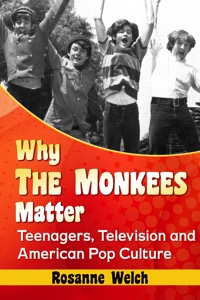This book signing at Book Soup was wonderful – good people, good conversation (before and after the signing). Just another example of the kind of quality positive people who have been drawn to The Monkees across generations – I even met a former head of publicity for ScreenGems who had some fun stories to tell. — Rosanne
Watch this entire presentation
Transcript:
The other thing that’s really interesting is they made a choice in the show for all the actors and musicians to use their own names as their characters. Any other show — The Partridge Family — they were The Partridge Family but that wasn’t their actual names in real life, but on The Monkees they were using their real names and this gets into a whole chapter i have on political ideology and identity. How we decide who’s who and how publicists had to decide how to present these people. Are they — first of all, when Davy got married they didn’t tell anybody because they thought all the girls would stop liking him, so how hard it is to be married in the real world and have to hide your wife and how much does she like not being able to tell people who she really is. They had to make choices about that and the idea that on concerts they were Micky Dolenz, Mike Nesmith, Davy Jones and Peter Tork and those were their names on the show. On the show they were a bunch of kids who couldn’t get a job to save their souls. So when the show was over that ability for Americans not be be able to separate out actors from characters was difficult. Because suddenly everyone thought that they were a couple of goofballs or they were famous rock stars who didn’t need to be actors anymore.
Buy “Why The Monkees Matter” Today!
Why The Monkees Matter: Teenagers, Television and American Pop Culture
McFarland (Direct from Publisher) | Amazon | Kindle Edition | Nook Edition
Podcast: Play in new window | Download
Subscribe: RSS
![Characters vs. Actors and The Monkees from Why The Monkees Matter Book Signing [Video] (1:10)](https://rosannewelch.com/wp-content/uploads/2017/07/wtmm-reading-14-characters-actors.jpeg)


![10 : Writers and The Monkees : “Why The Monkees Matter” Interview with Jean Power [Video] (0:44)](https://rosannewelch.com/wp-content/uploads/2017/07/rmw-power-10-writers.jpeg)

![Commentary, Comedy, and The Monkees from Why The Monkees Matter Book Signing [Video] (1:01)](https://rosannewelch.com/wp-content/uploads/2017/07/wtmm-reading-13-commentary.jpeg)

![09 : Only 2 Seasons : “Why The Monkees Matter” Interview with Jean Power [Video] (1:11)](https://rosannewelch.com/wp-content/uploads/2017/06/rmw-power-09-only-2-seasons.jpeg)
![Vietnam War and The Monkees from Why The Monkees Matter Book Signing [Video] (0:48)](https://rosannewelch.com/wp-content/uploads/2017/06/wtmm-reading-12-politics.jpeg)
![08 : TV vs. Movies : “Why The Monkees Matter” Interview with Jean Power [Video] (1:03)](https://rosannewelch.com/wp-content/uploads/2017/06/rmw-power-08-tv-movies.jpeg)

